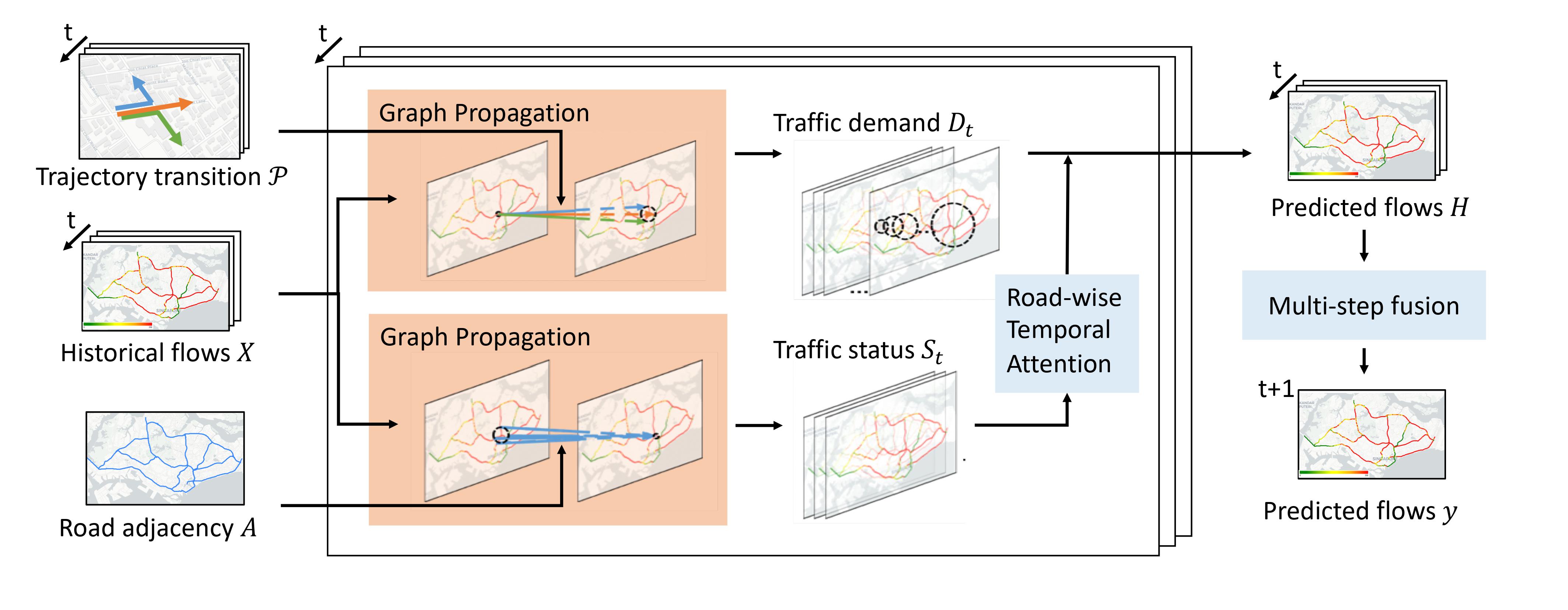This repository is a PyTorch implementation of the model TrGNN in the paper Traffic Flow Prediction with Vehicle Trajectories accepted at AAAI 2021 (pending release).
- PyTorch=0.4.1
- Python=3.7
- numpy=1.16.5
- scipy=1.3.1
- pandas=0.23.4
- geopy=1.20.0
- networkx=2.1
- statsmodels=0.9.0 (optional; for VAR only)
- scikit-learn=0.21.3 (optional; for RF only)
- folium=0.10.0 (optional; for visualization only)
- RawTaxiData ---
map matching---> ParsedTaxiData - ParsedTaxiData ---
trajectory.py---> recovered_trajectory_df - recovered_trajectory_df ---
trajectory_transition.py---> trajectory_transition - recovered_trajectory_df ---
flow.py---> flow - road_list & road_graph ---
train_model.py---> road_adj - trajectory_transition & flow & road_adj ---
train_model.py---> TrGNN
The list of road segments are indexed in file data/road_list.csv:
| road_id |
|---|
| 103103595 |
| 103103090 |
| ... |
The road graph is constructed with NetworkX and saved in GML format in data/road_graph.gml. Each node represents a road segment (label: road_id, length: in km), and each directed edge represents the adjacency between to road segments (weight: exponential decay of distance).
Trajectories after map matching (refer to Hidden Markov Map Matching) are saved at data/ParsedTaxiData_YYYYMMDD.csv:
| vehicle_id | time | matched_road_id |
|---|---|---|
| EEEEEEE | 14/03/2016 00:00:01 | 103064895 |
| AAAAAAA | 14/03/2016 00:00:10 | 103105500 |
| ... | ... | ... |
Note:
Files in the data folder contain dummy data for demo purpose. Real data have not been published due to confidentiality.
python trajectory.py -d 20160314 >> log/trajectory0314.logResults are saved at data/recovered_trajectory_df_20160314_20160314.csv:
| vehicle_id | trajectory_id | time | road_id | scenario |
|---|---|---|---|---|
| EEEEEEE | 0 | 14/03/2016 00:00:01 | 103064895 | 0.1 |
| EEEEEEE | 0 | 14/03/2016 00:00:13 | 103064811 | 3.1 |
| ... | ... | ... | ... | ... |
Similarly for other dates.
Note: The scenario column is for reference only (as documented in trajectory.py) and can be ignored.
python flow.py -d 20160314 -i 15 >> log/flow0314.logFlows are aggregated in 15-minute intervals, and are saved at data/flow_20160314_20160314.csv:
| road_id_0 | road_id_1 | ... | |
|---|---|---|---|
| 14/03/2016 00:00:00 | 33 | 67 | ... |
| 14/03/2016 00:15:00 | 21 | 89 | ... |
| ... | ... | ... | ... |
Similarly for other dates.
Run the following commands for baseline approaches.
# Historical Average. Modify `start_date` and `end_date` in code.
# Note: The dataset should cover more than 14 days.
python baseline.py -m HA
# Moving Average. Run on demo dataset for demo purpose.
python baseline.py -m MA -D demo
# Vector Auto-Regression. 5-hop neighborhood. Run on demo dataset for demo purpose.
# statsmodels package is required.
python baseline.py -m VAR -H 5 -D demo
# Random Forest. 5-hop neighborhood. 100 trees. Run on demo dataset for demo purpose.
# Note: It takes longer to run RF as it trains one model for each road segment separately.
# scikit-learn package is required.
python baseline.py -m RF -H 5 -n 100 -D demoThe test results of the baseline approaches above are saved at result/MODEL_Y_true.pkl (ground truth results), and result/MODEL_Y_pred.pkl (predicted results).
For Diffusion Convolutional Recurrent Neural Network, refer to its PyTorch implementation.
(Optional) Run the following command for one single date. Similarly for other dates.
python trajectory_transition.py -d1 20160314 -d2 20160314 >> log/transition0314.logThe result is a tensor of shape 96 (# 15-minute intervals of day), 2404 (# road segments), 2404 (# road segments) and is saved at data/trajectory_transition_20160314_20160314.pkl.
Run the following command for the training period.
python trajectory_transition.py -d1 START_DATE -d2 END_DATE >> log/transition0314.log# Train and test TrGNN. Run with GPU. Run on demo dataset for demo purpose.
python train_model.py -m TrGNN -D demo
# Train and test TrGNN-. Run with GPU. Run on demo dataset for demo purpose.
python train_model.py -m TrGNN- -D demoTrained models are saved at model/[MODEL]_[TIMESTAMP]_[EPOCH]epoch.cpt whenever the validation MAE breaks through.
The test results are saved at are saved at result/[MODEL]_[TIMESTAMP]_Y_true.pkl (ground truth results), and result/[MODEL]_[TIMESTAMP]_[EPOCH]epoch_Y_pred.pkl (predicted results). Results are of shape # test intervals, # road segments.
We run this repository on SG-TAXI dataset (not released) and evaluation results are summarized in the paper (pending release).
Refer to the second half (commented out) in utils.py for displaying road segments, road network, and vehicle trajectories. folium package is required.
(pending)

